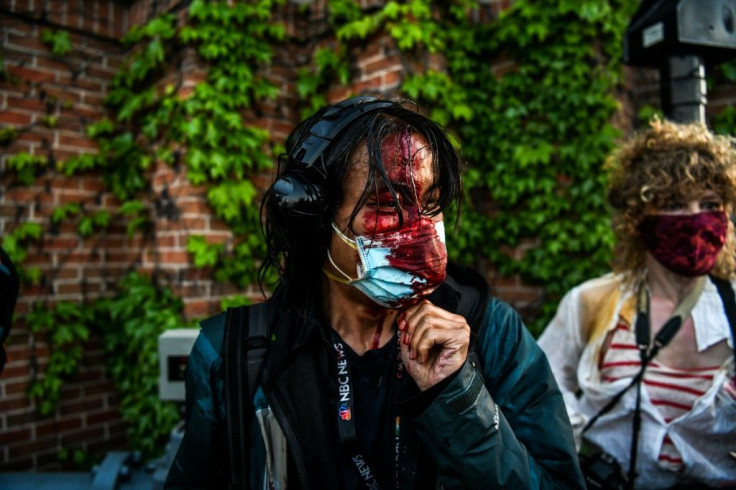Coronavirus At George Floyd Protests: Doctors Suggest Ways To Avoid Catching COVID-19
KEY POINTS
- There will be a jump in COVID-19 cases and deaths in the U.S. due to the George Floyd protests
- Doctors are encouraging protestors to wear facemasks, use hand sanitizer and wear eyeglasses
- Although odd, they also ask protestors to practice social distancing
Doctors are still warning the massive numbers of angry protestors, many of them unmasked, facing off with thousands of police across the United States in relentless George Floyd protests are fertile breeding grounds for the coronavirus that causes COVID-19. Some are suggesting ways to lessen the chance of both protestors and police contracting the coronavirus.
On the other hand, images of these confrontations make it seem as if there isn't a raging COVID-19 pandemic that's taken the lives of 108,000 Americans and sickened 1.88 million others as of Tuesday. SARS-CoV-2 (severe acute respiratory syndrome coronavirus 2) is the virus that causes COVID-19. It still has no cure.
Public health experts and government officials keep warning the large street protests over police brutality and the death of George Floyd now entering their eighth day will worsen the spread of SARS-CoV-2.
On Monday, Surgeon General Vice Admiral Dr. Jerome Adams said there will likely be a new rash of COVID-19 cases due to the ongoing protests.
"I remain concerned about the public health consequences both of individual and institutional racism (and) people out protesting in a way that is harmful to themselves and to their communities," Dr. Adams told Politico.
Dr. Abraar Karan, a public health expert and internist at Brigham and Women's Hospital and Harvard Medical School, said the protests carry with them "a high risk of spread in the sense that people are in close quarters with each other. They're screaming and yelling."
For his part, Dr. Ryan Demmer, an associate professor of epidemiology at the University of Minnesota, said it's difficult to imagine that U.S. will not see a spike in Covid-19 transmission due to the protests.
"Many days of large, in-person gatherings are powerful forces that can accelerate transmission," he pointed out.
New York Gov. Andrew Cuomo said the mass protests in his state and in New York City threaten the state’s progress in containing the spread of COVID-19. Despite the protests, New York City remains on track for its phase one reopening on June 8.
"We are doing very, very well when it comes to dealing with the Covid-19 crisis," he said.

But health authorities are moving to minimize the impending spike in COVID-19 cases. The California Department of Public Health (CDPH) has published recommendations for protesting while maintaining social distance. California is dissuading state residents from joining the protests out of health concerns, but if they do, asks them to take certain precautions.
It strongly recommends state residents use "alternative channels, such as the many online and broadcasting platforms available in the digital age, in place of in-person gatherings."
People that insist on in-person gatherings, however, must remain aware of guidelines limiting the number of protestors to 25% of the relevant area’s maximum occupancy. Protestors must maintain physical distancing of 6 feet between persons or groups of persons from different households.
"Failure to maintain adequate physical distancing may result in an order to disperse or other enforcement action. Face coverings are strongly recommended," said CDPH.
Doctors are also recommending protestors use the tried and true methods that have helped tamp-down the spread of COVID-19. These include:
- Using hand sanitizer and avoiding physical contact while greeting people, including shaking hands.
- Protesters should watch what they're touching. They should also avoid touching their eyes, nose and mouth.
- Wearing eye wear is strongly recommended.
- Protestors should maintain social distancing whenever possible. That means being at least 6 feet from others when possible.
“You can have a buddy system and stay in smaller groups," said Dr. Leana Wen, a professor of health policy and management at the George Washington University.
"Ideally, you want to stay away from big groups. Don’t hug and kiss. Don’t share drinks. Bring your own water bottle ... Don’t use the same microphone that’s been touched by hundreds of people.”
© Copyright IBTimes 2024. All rights reserved.





















